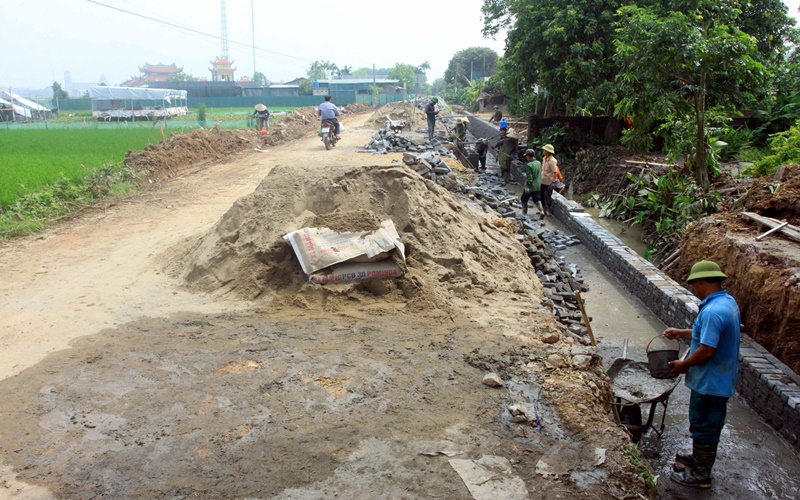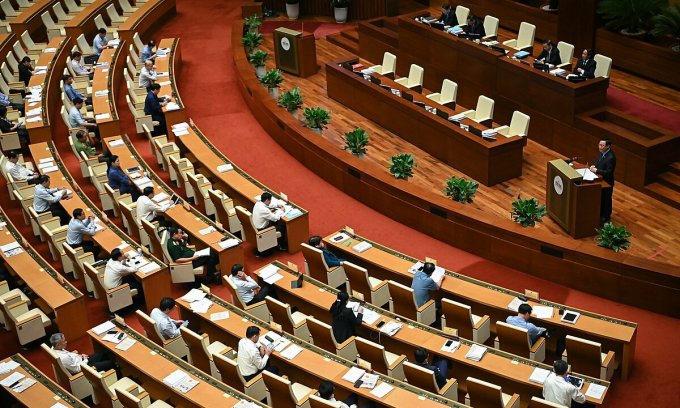Regulations on donating land for rural roads in Vietnam

Hello LSX. I currently live and work in my locality, recently it was decided in my area to rebuild rural roads. I have a question, how many meters must the widest rural road be in accordance with the regulations. In addition, I want to donate a bit of the remaining land of my house to build a road for the village, but I don’t know the current regulations on donating land for rural roads. So about the matter “Regulations on donating land for rural roads in Vietnam” Let’s find out with LSX in the article below.
Legal grounds
- Land Law 2013
What is land donation?
Although current legislation does not explain what “land donation” is. However, it can be understood that land donation is an act where a person with a land use right donates his/her land use right to an individual, state agency or organization, which here is the requirement to establish the land use right. change the land use right of the holder of the land use right.
People often get confused between land donation and land acquisition. However, it can be understood that if land acquisition is a mandatory rule to follow, if the person whose land is recovered does not comply, they will be fined on a case-by-case basis. voluntary of the owner.
Pursuant to the provisions of Clause 4, Article 146 of the 2013 Land Law, which stipulates as follows: “Residential communities build and embellish works serving the common interests of the community with capital contributed by the people or the State. the supporting country, the voluntary contribution of land use rights, compensation or support shall be agreed upon by the residential community and the land user.
Accordingly, it can be understood that land donation is not a case of land recovery, so when people donate land, they will not be supported or compensated by the State.
What is a country road?
Pursuant to Decision No. 4927/QD-BGTVT stipulates: “Rural roads (GTNT) include routes connecting national highways and provincial roads to villages, hamlets, fields and farms. farms, production facilities, animal husbandry … serving the production of Agriculture – Forestry – Fisheries and the economic – cultural – social development of the localities.
According to that regulation, it can be understood that rural roads are understood as paths of people living in small localities. Rural roads include roads such as:
District road: A district road is a road connecting the administrative center of that district with administrative centers of communes, wards, townships or administrative centers of neighboring districts; Road plays an important role in the socio-economic development of the district.
Communal and inter-commune trunk roads: This is the type of road connecting the commune administrative center with villages or the road connecting communes with grade IV design. This type of road does not belong to the district road.
Village roads: These are roads connecting villages and hamlets together.
Neighborhood road: A road connecting households together
Intra-field main roads: These are the main roads connecting the fields to residential areas.
Regulations of the law on building new rural roads?
Currently, the law also has very specific regulations related to the area of rural roads when conducting road construction, specifically detailed regulations in Decision No. 4927/QD-BGTVT. According to this rule we can define the area as follows:
Rural roads have grades: Grade A, B, C, D. And the technical standards of each type of road are as follows:
For grade A roads:
– Calculation speed: 30 (20) km/h;
– Minimum road surface width: 3.5 m;
– Minimum curb width: 1.50 (1.25) m;
– Minimum roadbed width: 6.5 (6.0) m;
– The largest super-elevation slope: 6%;
– Minimum lying curve radius: 60 (30) m;
– The minimum lying radius of the curve is not super-elevated: 350 (200) m;
– Maximum vertical slope: 9 (11)%;
– Maximum length of the section with longitudinal slope greater than 5%: 300 m;
– Static clearance: 4.5 m.
For road grade B
– Calculation speed: 20 (15) km/h;
– Minimum road surface width: 3.5 (3.0) m;
– Minimum curb width: 0.75 (0.5) m;
– Minimum width of roadbed: 5.0 (4,0) m;
– Maximum super-elevation slope: 5%;
– Minimum lying curve radius: 30 (15) m;
– Maximum vertical slope: 5 (13)%;
– Maximum length of the section with longitudinal slope greater than 5%: 300 m;
– Static clearance: 3.5 m.
For road grade C
– Calculation speed: 15 (10) km/h;
– Minimum road surface width: 3.0 (2.0) m;
– Minimum roadbed width: 4.0 (3.0) m;
– Minimum lying radius: 15 m;
– Maximum vertical slope: 5 (15)%;
– Maximum length of the section with longitudinal slope greater than 5%: 300 m;
– The clearance for traffic is not less than 3.0 m.
For DU grade road
– Minimum road surface width: 1.5 m;
– Minimum roadbed width: 2.0 m;
– Minimum lying radius: 5 m;
Regulations on donating land for rural roads in Vietnam
Land donation is one of the people’s rights. When realizing that donating land for rural roads is reasonable and ensures benefits for both parties, land users can completely make such donation. Besides, they can also request competent state agencies to support them with benefits related to the land they will donate for rural roads.
Pursuant to the provisions of Article 66 of the Land Law 2013, the authority to recover land is as follows:
“first. Provincial-level People’s Committees shall decide to recover land in the following cases:
a) Recover land from organizations, religious establishments, overseas Vietnamese, foreign organizations with diplomatic functions, foreign-invested enterprises, except for the case specified at Point a. b Clause 2 of this Article;
b) To recover agricultural land belonging to the public land fund of communes, wards and townships.
2. District-level People’s Committees shall decide to recover land in the following cases:
a) Recovery of land from households, individuals and communities;
b) Recover residential land from overseas Vietnamese who are entitled to own houses in Vietnam.
3. In case there are both subjects specified in Clauses 1 and 2 of this Article in the land recovery area, the People’s Committee of the province shall decide on land recovery or authorize the People’s Committee of the district to decide on land recovery. soil.”
Thus, according to the above law, it can be understood that the authority to recover land of people who voluntarily donate land for road construction will be given by the People’s Committee of the district where the land is located.
When the land has been donated to build a road, is there still a right to use that land?
To explain this issue, based on Article 65 of the 2013 Land Law, which stipulates the recovery of land due to voluntary return of land as follows:
“first. Cases of land expropriation due to termination of land use according to law, voluntary return of land, and threats to human life include:
a) An organization that is allocated land by the State without collection of land use levy or is allocated land by the State with the collection of land use levy and whose land use levy is derived from the state budget is dissolved, bankrupt, or relocated to a new location. other, reduce or no longer need to use land; users of land leased from the State paying annual land rents are dissolved, go bankrupt, move to another place, reduce or no longer need to use land;
b) The individual using the land dies without an heir;
c) The land user voluntarily returns the land;
d) Land allocated or leased by the State for a definite term but not extended;
dd) Residential land in an area with environmental pollution that poses a threat to human life;
e) Residential land at risk of landslide, subsidence, affected by other natural disasters threatening human life.
2. The land recovery prescribed in Clause 1 of this Article must be based on the following grounds:
a) The legally effective document of the agency competent to handle the land recovery case specified at Point a, Clause 1 of this Article;
b) The death certificate or the decision declaring a person dead as prescribed by law and the written certification of the absence of an heir issued by the commune-level People’s Committee of the place where the deceased person’s heir permanently resides; for the case of land recovery specified at Point b, Clause 1 of this Article;
c) The land user’s written return, for the case specified at Point c, Clause 1 of this Article;
d) Decision on land allocation, decision on land lease, for the case specified at point d, clause 1 of this Article;
dd) Document of the competent authority determining the level of environmental pollution, landslide, subsidence, affected by other natural disasters threatening human life, for the cases specified at Points dd and d. Point e, Clause 1 of this Article.
3. The Government shall detail this Article.”
Accordingly, when the state recovers land when people voluntarily donate land, people no longer have the right to use the land. In other words, at this time, the land that people have donated will be cut off from their land use right certificates and this land instead of the private use of the family has been put into common use community and nominally the committee land under the management of the state.
In case, people have donated land to build a road but after a period of time no longer use that road, people can also be considered for land redistribution, specifically at this time people need to prepare the necessary measures. documents prescribed in Article 4 of Circular 30/2014/TT-BTNMT providing for documents on land allocation, land lease, change of land use purpose, and land recovery issued by the Minister of Natural Resources and Environment as follows:
“1. The applicant for land allocation or land lease shall submit 01 set of documents specified at Points a and d, Clause 1, Article 3 of this Circular;
2. A dossier to be submitted to the People’s Committee of a district, urban district, town or provincial city (hereinafter referred to as district level) for decision on land allocation or land lease made by the Division of Natural Resources and Environment includes:
a) The papers specified in Clause 1 of this Article;
b) Written assessment of land use demand; appraise the conditions for land allocation and land lease as prescribed in Clause 3, Article 58 of the Land Law and Article 14 of Decree No. 43/2014/ND-CP;
c) A statement enclosed with the draft decision on land allocation (Form 02) or the draft decision on land lease (Form 03) issued together with this Circular.”
It can be seen that when people want to get back the land that people have donated as a rural road, but later that road is no longer available, there is no need to use it anymore and the people’s committees at all levels agree, the people must file an application to hand over that land.
Services of LSX
Prestigious professional services: Firstly, the team of consultants and consultants for many years in the field of civil status, and customer support.
On-time: Certainly, with the motto “Get your lawyer right at your fingertips”, we ensure the service always performs on time. The rights and interests of customers always come first.
Cost: Besides, LSX’s service costs are highly competitive; depending on the nature of the particular case. So, we want our guests to have the best possible service experience. Therefore, costs which guaranteed to be the most suitable and economical for customers.
Confidentiality of client information: Finally, all brand information of client LSX will be 100% confidential.
Please contact us immediately if you have any questions about “Regulations on donating land for rural roads in Vietnam”
Contact LSX
Finally, hopefully the information in the article will provide helpful information for readers and help you solve the problem “Regulations on donating land for rural roads in Vietnam” At the same time, LSX Law firm always has leading lawyers and legal consultants who will help you in legal matters of life. If you have any need, please get in touch with us via hotline: +84846175333 or Email: [email protected]
Please see more
- Regulations on undivided land of inheritance in Vietnam
- Change of land use purpose in Vietnam to implement investment projects
- Who can buy rice land under Vietnam law?
Frequently asked questions
First, unconditional donation: That is, people voluntarily donate land to state agencies to perform public works without asking for anything, the land donor will benefit most when it is convenient to do business. or land prices increase.
Second, conditional donation: Because land donation is not a mandatory case, there is no coercive factor, so the land donor has the right to demand that the people directly benefit from this road pay compensation or support themselves a certain amount in a reasonable and reasonable manner in accordance with the provisions of law.
According to Article 459 of the Civil Code 2015 and Article 73 of Decree 43/2014/ND-CP on submission and registration procedures for establishment, change or termination of limited use right of the adjacent land plot. The donation of land for road construction can only be completed when the competent authority makes a decision to receive and recover the donated land for successful acquisition.
Land owners submit a set of documents at the Land Registry Office. Profile includes:
Application for registration of changes in land and properties attached to land
Original Certificate issued by a party or related parties
Contract or written agreement on establishment, change, termination of limited use right of adjacent land plot
The diagram shows the location and size of the land plot area
Conclusion: So the above is Regulations on donating land for rural roads in Vietnam. Hopefully with this article can help you in life, please always follow and read our good articles on the website: lsxlawfirm.com




